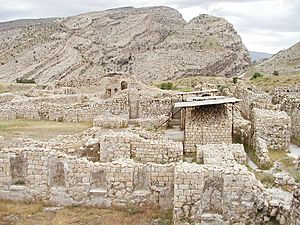Bishapur facts for kids
|
in Persian: بیشاپور
|
|

The ruins of Bishapur
|
|
| Alternative name | Bishâpûr |
|---|---|
| Location | Kazerun, Fars Province, Iran |
| Coordinates | 29°46′40″N 51°34′15″E / 29.77778°N 51.57083°E |
| Type | Settlement |
| History | |
| Founded | 226 AD |
Bishapur (pronounced Bee-shah-poor) was a very old city in Iran. It was built a long, long time ago during the time of the Sasanian Empire. This empire was a powerful kingdom in ancient Persia.
Bishapur was an important city because it was located on a main road. This road connected two big Sasanian capital cities: Istakhr (near Persepolis) and Ctesiphon. Today, you can find the ruins of Bishapur south of a modern town called Faliyan. It is in the Kazerun County of Fars Province, Iran.
Contents
What Was Bishapur?
Bishapur was more than just a city. It was a planned city built by Shapur I, a powerful Sasanian king. He started building it around 226 AD. The city was designed with straight streets, like a grid. This was a new idea for cities in that region at the time.
Why Was Bishapur Important?
Bishapur was special for a few reasons. King Shapur I built it after winning battles against the Roman Empire. He even used Roman prisoners of war to help build parts of the city. This mix of Persian and Roman styles made Bishapur unique.
The city had a royal palace, a fire temple, and other important buildings. Many of these buildings had beautiful decorations. These included detailed stone carvings and colorful mosaics. The mosaics often showed scenes of nature, like flowers and birds.
Life in Ancient Bishapur
People lived in Bishapur for many centuries. It was a busy place for trade and culture. The city was a center for the Sasanian kings. They used it as a place to live and to show off their power.
Over time, the city slowly lost its importance. Eventually, it was abandoned. Today, Bishapur is an amazing archaeological site. It helps us learn about the Sasanian Empire and its art and architecture.
Images for kids
-
Persian-Roman floor mosaic detail from the palace of Shapur I at Bishapur. Presently housed in the National Museum of Iran
See also
 In Spanish: Bishapur para niños
In Spanish: Bishapur para niños





